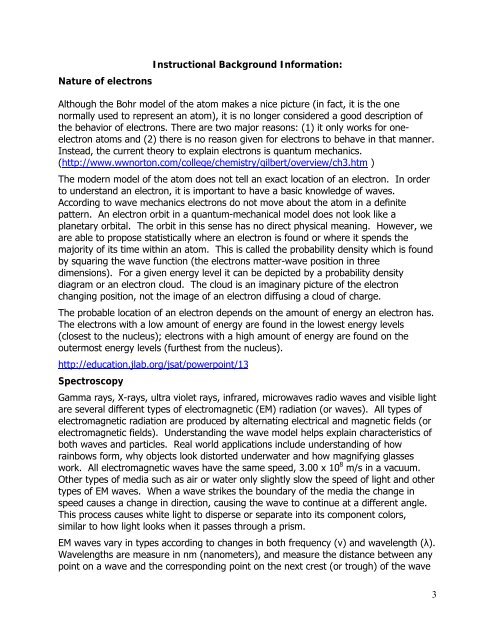Electrons and Quantum Mechanics - Oakland Schools
Electrons and Quantum Mechanics - Oakland Schools
Electrons and Quantum Mechanics - Oakland Schools
Create successful ePaper yourself
Turn your PDF publications into a flip-book with our unique Google optimized e-Paper software.
Nature of electrons<br />
Instructional Background Information:<br />
Although the Bohr model of the atom makes a nice picture (in fact, it is the one<br />
normally used to represent an atom), it is no longer considered a good description of<br />
the behavior of electrons. There are two major reasons: (1) it only works for oneelectron<br />
atoms <strong>and</strong> (2) there is no reason given for electrons to behave in that manner.<br />
Instead, the current theory to explain electrons is quantum mechanics.<br />
(http://www.wwnorton.com/college/chemistry/gilbert/overview/ch3.htm )<br />
The modern model of the atom does not tell an exact location of an electron. In order<br />
to underst<strong>and</strong> an electron, it is important to have a basic knowledge of waves.<br />
According to wave mechanics electrons do not move about the atom in a definite<br />
pattern. An electron orbit in a quantum-mechanical model does not look like a<br />
planetary orbital. The orbit in this sense has no direct physical meaning. However, we<br />
are able to propose statistically where an electron is found or where it spends the<br />
majority of its time within an atom. This is called the probability density which is found<br />
by squaring the wave function (the electrons matter-wave position in three<br />
dimensions). For a given energy level it can be depicted by a probability density<br />
diagram or an electron cloud. The cloud is an imaginary picture of the electron<br />
changing position, not the image of an electron diffusing a cloud of charge.<br />
The probable location of an electron depends on the amount of energy an electron has.<br />
The electrons with a low amount of energy are found in the lowest energy levels<br />
(closest to the nucleus); electrons with a high amount of energy are found on the<br />
outermost energy levels (furthest from the nucleus).<br />
http://education.jlab.org/jsat/powerpoint/13<br />
Spectroscopy<br />
Gamma rays, X-rays, ultra violet rays, infrared, microwaves radio waves <strong>and</strong> visible light<br />
are several different types of electromagnetic (EM) radiation (or waves). All types of<br />
electromagnetic radiation are produced by alternating electrical <strong>and</strong> magnetic fields (or<br />
electromagnetic fields). Underst<strong>and</strong>ing the wave model helps explain characteristics of<br />
both waves <strong>and</strong> particles. Real world applications include underst<strong>and</strong>ing of how<br />
rainbows form, why objects look distorted underwater <strong>and</strong> how magnifying glasses<br />
work. All electromagnetic waves have the same speed, 3.00 x 10 8 m/s in a vacuum.<br />
Other types of media such as air or water only slightly slow the speed of light <strong>and</strong> other<br />
types of EM waves. When a wave strikes the boundary of the media the change in<br />
speed causes a change in direction, causing the wave to continue at a different angle.<br />
This process causes white light to disperse or separate into its component colors,<br />
similar to how light looks when it passes through a prism.<br />
EM waves vary in types according to changes in both frequency (ν) <strong>and</strong> wavelength (λ).<br />
Wavelengths are measure in nm (nanometers), <strong>and</strong> measure the distance between any<br />
point on a wave <strong>and</strong> the corresponding point on the next crest (or trough) of the wave<br />
3
















